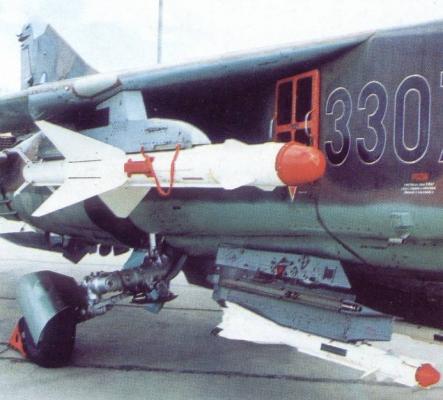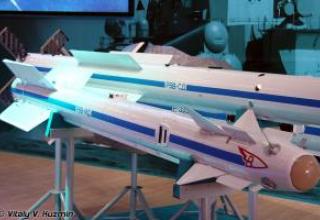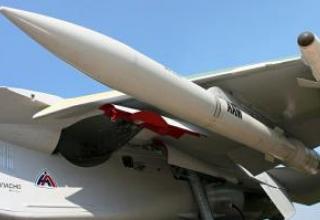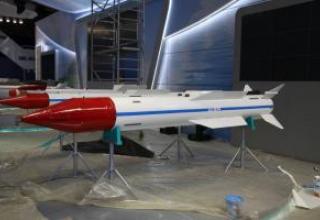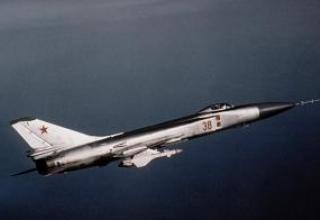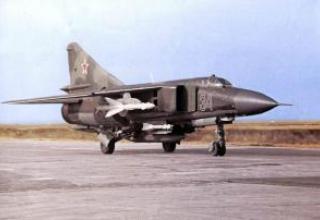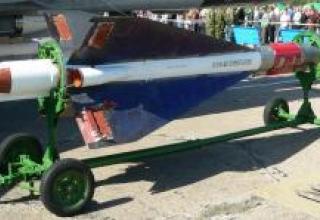With the introduction of anti-aircraft missile systems in the Soviet troops fighter-bombers of NATO countries have taken action at extremely low altitudes. For the MiG-23 frontline interceptor, which was being created at that time, the task of detecting targets against the ground became especially important.
The missile for the MiG-23 was created in two versions: "product 340" with the "radius" SSS developed by NII-339 and "product 360" with a thermal homing head TGS-23, designed in the Central Design Bureau-589. For the first time in our country a special element base - flat micromodules - was created for K-23 missile onboard equipment. The combat unit of the missile was created by the GSCB-47, the engine - KB-2 of plant №81, solid fuel charge - Research Institute-130.
To test the aircraft radar "Sapphire-23", heat transfer TP-23 and homing equipment created a flying laboratory LL-110 based on the Tu-110 ¹ 5511. The machine was modified in Zhukovsky, on the flight test base of Plant 23. In the nose section in the elongated fairing was placed radar "Sapphire", under the wing was equipped with a suspension in the form of a special gondola to accommodate GSN, connected to the equipment installed in the passenger cabin. The research carried out at this flying laboratory allowed to accumulate a large amount of material on the characteristics of signals reflected from different underlying surfaces, and to develop effective methods of selection of moving objects.
The first flight of the LL-110 took place on March 31, 1966, with eight more flights completed by the end of the year. The following year, about half of the 13 flights were carried out specifically for the study of CLO. To accelerate the process of testing involved a flying laboratory based on a mass jet aircraft Tu-104 ¹ 42498, designated LL-104/23. Its first flight took place on November 1, 1968. In the course of testing in the flying laboratories was confirmed the range of the target COS Tu-16 26-30 km.
In 1966, were made dimensional weight models of missiles with a "radius" and thermal SLN. The following year, along with the models produced launch ("product 362"), software ("product 363") and telemetry ("product 365") missiles in the thermal version. To begin with, four "item 362" were launched from a ground-based free-floating launcher.
Flight autonomous development of missiles began on a specially modified in early 1967, the MiG-21PF number 1203 (aka E-7 with K-23), specially equipped with a free-standing launcher for K-23. By the end of the year there were 17 flights with K-23, having made eight autonomous launches of "362" and "363". Next year, the aircraft rose 43 times in the air and made 14 launches of program and telemetry missiles.
In early 1968, the MiG-21S ¹102 (also known as E-7 with K-23T) was rebuilt, on which a container with equipment that provides the use of full-fledged K-23 with thermal GSN was installed. By the end of the year 14 flights with missiles were performed and one launch of the K-23T was made, thus starting the first stage of state tests. In autumn, the MiG-21S radar was improved, ensuring its use in launching K-23T missiles with zero preemptive angle. A total of 33 launches were performed from two carriers in 1968, including 20 program and 13 telemetry missiles. In the same year, held test flights of the first prototype MiG-23 with four mock-up missiles, designed to determine the characteristics of the aircraft with a full set of missile weapons.
Since 1969. began to launch guided missiles on air targets. The second and fourth prototypes of MiG-23 performed 12 and four autonomous launches, respectively, and the prototype number 3 - the launch of a telemetry missile on IL-28. MiG-21C #102 was launched against MiG-17, IL-28 and M-6 parachute targets. In total, 19 launches of K-23T were made in 1969. On the MiG-21S ¹102 were tested regular launches APU-23-11 and catapult AKU-23-11, designed for under the fuselage suspension of missiles and has not received further development. As a result, MiG-23 "pulled" only a couple of K-23.
Phase of factory tests K-23T completed in 1970, during which 18 launches of ballistic and telemetry missiles with the MiG-21C ¹ 102, MiG-23 ¹ 236, 239, 402, 404 and shot down two La-17MM. Development of the thermal variant lasted more than two years.
In early 1972, the first stage of state testing was completed, and in June-October the program of the second stage was implemented. In total, 29 launches were made in 1972. The Act on the results of joint state trials of K-23T was approved on April 11, 1973. MiG-23 ¹1801, 902, 602 and MiG-23M ¹1201 and 1203 took part in them. Unmanned MiG-17, MiG-19, Yak-25RV, IL-28 as well as parachute targets and RM-8M were used as targets. In the course of the tests, the previously used "solid" submachine guns-23-11 were replaced by lighter submachine guns-23M with launch guide on two supports.
However, if the work on the "thermal" rocket little depended on the avionics of the aircraft, the development of the "radius" rocket could be carried out in due amount only after bringing the radar "Sapphire-23" to a working condition, although the first autonomous launches K-23R performed back in 1969, and the first firing on the target took place in 1970 with the aircraft MiG-23 ¹ 236 and 239. The novelty of many technical solutions for the Sapphire-23 radar resulted in multiple shifts in the set completion dates. All this could not but affect the time of missile development.
In the course of launches with the MiG-23 revealed the effect of "pre-arrival dazzling" radar GSN missile radiation close to the aircraft radar on the side petals of the directional pattern. This phenomenon did not fully manifest itself in the flights of flying laboratories based on Tupolev airliners because of the more distant location of the aircraft radar relative to the homing heads, placed in special underwing containers. The apparent inoperability of the CNS under these conditions was considered by a commission headed by the Minister of Radioelectronic Industry P.S. Pleshakov. In this situation, an innovative solution was born - to move to the capture of the target SOS in flight, after the launch from the carrier. The first launch under this scheme was held in the last days of 1970. Although it was not possible to hit the target, the capture in flight was successful. Later on, the training was quite successful.
The gap between the "radium" variant and the thermal variant was very large. In 1972, 19 launches were made, including MiG-17, but at the same time they revealed a defect of CNS, which required a thorough revision. Shots were already fired from the launch submersibles-23M. In 1972, 15 launches were made at stage A of state tests, which due to MiG-23 repair ¹1203 was completed only in April 24, 1973. The corresponding document was approved almost simultaneously with the signing of the final act on K-23T. Further progress of work was accelerated, which allowed to sign the Act on Stage B on October 15, 1973. In total, 37 launches were made in 1973. As a result, it was possible to put the K-23R into service simultaneously with the thermal version and the MiG-23M aircraft.
By a decree of the Party and Government of January 9, 1974, a full-fledged version of the aircraft that met the original design was put into service - MiG-23M with the Sapphire-23 radar, designated RP-23, and K-23 missiles with radar and thermal GSN under the indices R-23R and R-23T respectively. The serial production of R-23 missiles was carried out at Kovrov Mechanical Plant.
The Mig-23 R-23 fighter was exported to Afghanistan, GDR, Algeria, Angola, Bulgaria, DPRK, Cuba, Slovakia, Ethiopia, India, Iraq, Libya, Poland, Romania, Czech Republic, Syria, Sudan and Yugoslavia.
The R-23 were baptized in 1982 during the Lebanese War, where they shot down at least 6 Israeli Air Force aircraft. Most of the launches from Syrian Mig-23 were made on counter courses from a distance of 10-18 km without visual visibility of the target, and the rupture of a powerful combat unit even 20 meters away from the enemy aircraft rendered it inoperable.
In general, the creation of the K-23 was a great achievement of the domestic rocket industry. For the first time in our country was designed a missile capable of hitting targets on the background of the earth's surface. Thus, the capabilities of the Mig-23 fighter were brought into line with the methods of tactical aircraft of the enemy, which since the end of the 1950's switched to low altitude strikes.
R-23 missile for about 10 years maintained superiority in terms of tactical and technical characteristics over similar foreign missiles in terms of performance in a complex information environment, interference immunity from all known types of active combined interference and in conditions of reflections from the underlying surface during an attack of a low-flying target. Only in 1982, the AIM-7M Sparrow missile with Doppler monopulse homing head reached a parity level with the R-23 missile.
Further development of R-23 missile was a medium-range missile R-24, which belonged to the third generation of aircraft missiles.
Abroad, the R-23 missile was designated AA-7 Apex.
Composition:
The R-23 rocket (see projections) was made according to the normal aerodynamic scheme, with small trapezoidal stabilizers of small elongation and consisted of six compartments. The missile was equipped with a semi-active homing radar head RGS-23 or thermal TGS-23, which were located in the first compartment. The rocket with a homing head, designated R-24T was equipped with destabilizers in 1.6 times smaller area compared to the "radius" (R-24R), than achieved the proximity of the dynamic parameters of both versions of the missile at various rounds and masses of the front of the body.
In the second compartment there was a radio detonator "Chaika", in the third - an autopilot. The fourth compartment was occupied by a shrapnel-rod combat unit and a safety executive mechanism. The combat unit contained 6kg of explosives and a net of two rows of rods laid on a profiled bed, which formed a ring with a radius of 8m when detonated.
The fifth compartment contained a turbo-generator unit and a small-size gas generator for powering the steering vehicles. The sixth compartment was a solid fuel engine PRD-194. Around the extended engine nozzle block there were seventh and eighth compartments with steering machines - one for each steering wheel. On the outer surface of the engine, along with a box of on-board cable network, there was a gas duct designed to power the steering machines placed in the tail compartment. Wedge clamps connected almost all the compartments except for the two tail compartments that were telescopically joined together. The missile was delivered as assembled, except for the wings that were joined together in the troops.
Before the launch of the aircraft equipment on the missile was introduced target designation within ± 50 ° for radar and ± 55 ° for thermal GSN. In the conditions of work located at close range of a powerful airborne radar carrier with a continuous signal illumination of the first domestic Doppler monopulse semi-active head RGS-23 could not capture the target for car escort, being on the suspension under the aircraft. The first 3s flight of the missile was carried out in an autonomous mode with the development of a special program, taking the missile from the carrier to avoid collision. Then the CLO was searching for a target and its capture for escort. With minor aiming errors, the launch range could be one and a half times greater than the range of the CNS capture. Homing head RGS-23 was equipped with a receiver with highly stable characteristics, so that in the process of operation there was no need to perform special operations to adjust its parameters. An important innovation of the CNS was the ability to automatically adjust its heterodyne to the literal frequency of the aircraft carrier radar. As a result, there was no need for a literal execution of missiles.
High combat capabilities were also possessed by "thermal" missiles with GSN cooled by nitrogen fed from the launch device APU-23M. For these missiles, the capture of the target for car escort was made before the launch of the missile. The range of capture was 16 km, the launch could be carried out with an overload of up to 5g. Hypersensitivity of the homing head 23T3 (TGS-23) made it possible to attack the enemy aircraft and the front hemisphere - to capture the target was enough even relatively weak kinetic heating of the front edges of the aircraft.
At the same time, the R-23 proved to be quite difficult to operate and included built-in test circuits. This required the pilot to accurately follow the sequence of operations to prepare the missile before launch. And yet, according to the data from launches conducted in 1975-78. to hit one target required: 1.8-2 missiles R-23R, 1.1-1.2 R-23T and 1-1.5 R-60.
R-23UT "flying" missiles and R-23UD "technical" missiles were intended for training ground personnel.
Characteristics:
| R-23R | R-23Т | |
| Range of fire, km : - in the front hemisphere - in the back hemisphere |
27 15 |
|
| Maximum flight speed, M | 3 | |
| Battle ceilings, m | 40-25000 | |
| Dimensions, mm: - length - diameter - wingspan |
4460 200 1000 |
4180 200 1000 |
| Starter weight, kg | 223 | 217 |
| Weight of combat unit, kg | 25 | |
Testing:
It is alleged that two projectiles were launched towards the Israeli capital, the city of Tel Aviv, from Gaza on the evening of 15 November 2012.
The Palestinian terrorist organization Al-Quds Brigades, the militant wing of the Islamic Jihad, claimed responsibility for the shelling. According to their statement, two Fadjr-5 rockets were fired towards Tel Aviv, indicating that the group had hundreds of such rockets.
Sources:
- В.Марковский, К.Перов Советские авиационные ракеты "воздух-воздух"-М.: ООО "Издательский дом "Экспринт", 2005.-48с.
- 


